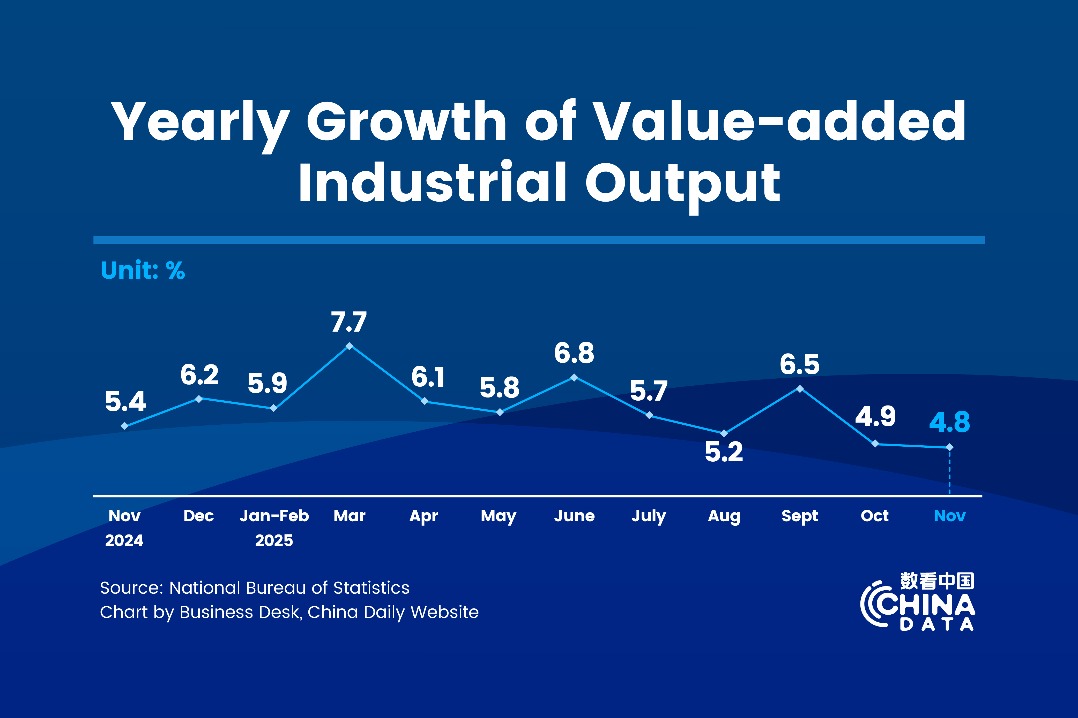Investment, reforms key to growth this decade


The path taken by economic growth is never straight and economists are deeply divided on the causes that have led to China's recent economic downturn. Is it cyclical, structural, or due to something else?
Cyclical fluctuations appear to be inevitable in any economy, and China is no exception. Some economists have blamed the so-called structural factors, such as lagging institutional reforms, a shrinking demographic dividend, and lack of innovation, for the current downturn. But such factors can't explain the downturn.
For, changes in demographics generally affect economic growth gradually over the long term. And China's level of innovation is actually rising rapidly.
It is not some supply-side structural factors but demand-side factors that have contributed to the slowdown.
As the growth of China's investments, exports and consumption declined significantly between 2013 and 2018, so did its GDP growth rate, mainly due to the nosedive in fixed-asset investment growth.
Note: All growth rates in this article are real after adjusting for price changes. In most years, data on real growth rates in consumer retail sales and fixed-asset investments are released by the National Bureau of Statistics. In the absence of NBS data, the author has calculated real growth rates by subtracting the relevant price index from the nominal growth rates.
After 2013, government policy goals became more diversified. Instead of simply pursuing higher GDP growth as it had done before, the Chinese government turned its attention to environmental protection and fighting government corruption, which cooled the investment scene, naturally putting a brake on China's economic surge as the investment boom leveled off.
Fiscal and monetary policies became more contractionary than expansionary, perhaps as a defensive reaction to a flurry of criticism leveled at the strong stimulus policies rolled out in 2009. Investment and export growth slid dramatically between 2014 and 2015.
The so-called "pro-cyclical" tightening policy in the midst of a significant economic downturn was adopted because of some fundamental misconceptions about the Chinese economy. Specifically, the importance of investment in economic growth was underestimated, while the extent of loose money supply and high corporate leverage was overestimated.
As investment rates were significantly higher in China than in other countries, many economists believed that China had been relying too much on investment to drive economic growth, which not only generated overcapacity, but also a high leverage ratio in the corporate sector. Based on this premise, China's economic downturn could be blamed on excess aggregate supply, rather than insufficient aggregate demand, hence the need to cut overcapacity and deleverage.
Another misconception was that there was an excess in China's money supply, as reflected in the high M2/GDP ratio, which had created asset bubbles, especially in the real estate sector, and increased leverage in the corporate sector, leading to high financial risks.
According to various sets of data, China's M2/GDP ratio hit 2.08 in 2016, amongst the highest in the world, more than twice that of the US, and three times the global average. In this sense, China's M2/GDP ratio seemed to be too high. Nevertheless, there are no economic theories indicating that a high M2/GDP ratio is bad for an economy. The relatively high M2/GDP ratio in China should be no surprise, since M2 is largely synonymous with bank deposits, which have become the primary savings vehicle, giving rise to a high M2/GDP ratio.
Rising M2/GDP ratios between 2006 and 2016 was a global phenomenon and not unique to China. In fact, China's M2/GDP growth rate was below the global average (39.48 percent), while even the US was experiencing a surge of 21.48 percent.
The past decade has seen money supplies growing rapidly around the world, in stark contrast to slower GDP growth, lower inflation rates, and lower interest rates. This is a new macroeconomic phenomenon that is still little understood.
To understand the mid-to-long-term prospects for China's economy, we need to first distinguish economic fluctuation from economic growth.
In economics, economic growth generally refers to the sustained increase in a country's capacity to produce goods and services over a mid-to-long-term period, while economic fluctuation refers to the short-term ups and downs in GDP growth rates along a long-term growth trend.
By definition, economic growth is about increasing production and supply, not about demand. Consequently, the three drivers of long-term economic growth are physical capital accumulation (investment), human capital accumulation (education), and technological progress, and not the troika of consumption, investments and exports often cited in the media.
The latter are three demand-side factors that affect short-term economic fluctuations. The only common element between the two sets of factors is investments, because they generate both short-term demand and long-term supply.
With regards to the first engine of economic growth, China's investment rate, which has been among the highest in the world for around three or four decades, is underpinned by China's high savings rates, and is therefore a major driver of China's rapid growth.
For the second engine of growth, latest research shows that the quality of basic education is the best predictor of a country's economic growth. The quality of China's basic education now matches the levels achieved in developed countries, forging solid foundations for economic growth.
Finally, the impact that education has on economic growth in developing countries is primarily from people being able to capitalize on advanced technologies learnt from developed countries. A number of indicators show that the pace of technological progress in China is the fastest in the world, providing the third engine powering China's economic growth.
China would score very well on investment, quality of education and speed of technological progress over the past four decades of rapid growth, thanks mainly to the central values that characterize the Confucian culture, which are the importance attached to education and thrift.
So long as China pursues its course to becoming a more market-oriented economy and continues to implement policies that enshrine reform and opening-up in the rule of law, it should join the ranks of developed high-income countries in the foreseeable future.
Exports to the United States only make up less than 4 percent of China's GDP. Even if the US imposed a 25-percent tariff on all exports from China to the US, the short-term impact on China's GDP growth would still be limited.
Looking at the longer term, trade friction may trigger a technology war. While such tension could hamper China's technological progress, it could also be the catalyst for home-grown innovation.
External trade frictions may slow the rapid rise of China's economy, but they cannot reverse it. The real engine that will determine its longer term economic progress in the future lies within China itself.
In the short term, therefore, China needs to loosen up those fiscal and monetary policies that have been overly contractionary in recent years.
In the longer term, China will be able to depend on investment, quality education, and rapid technological progress to achieve medium to long-term economic growth.
So long as China keeps its course toward a more market-led and rule-based economic system, its economy will be able to achieve a medium-to-high-speed growth of 6 percent to 8 percent over the next decade.
Zhu Tian is the Santander Chair in Economics and an Associate Dean at the China Europe International Business School or CEIBS in Shanghai.




































